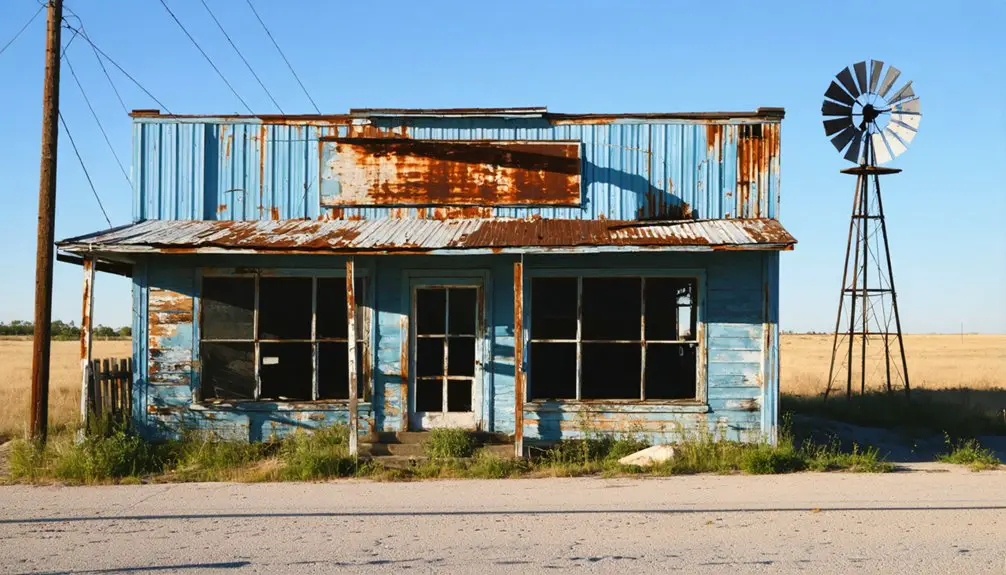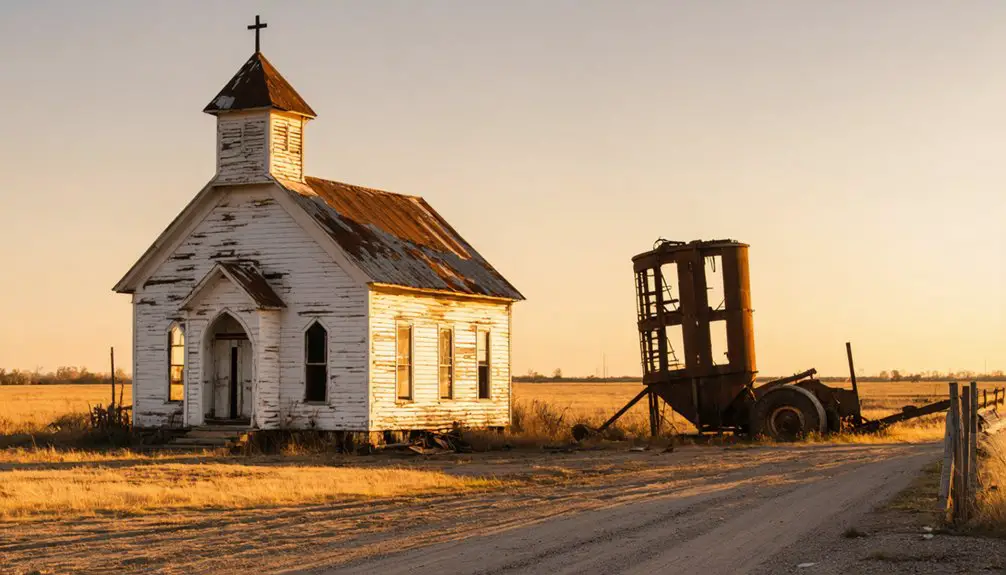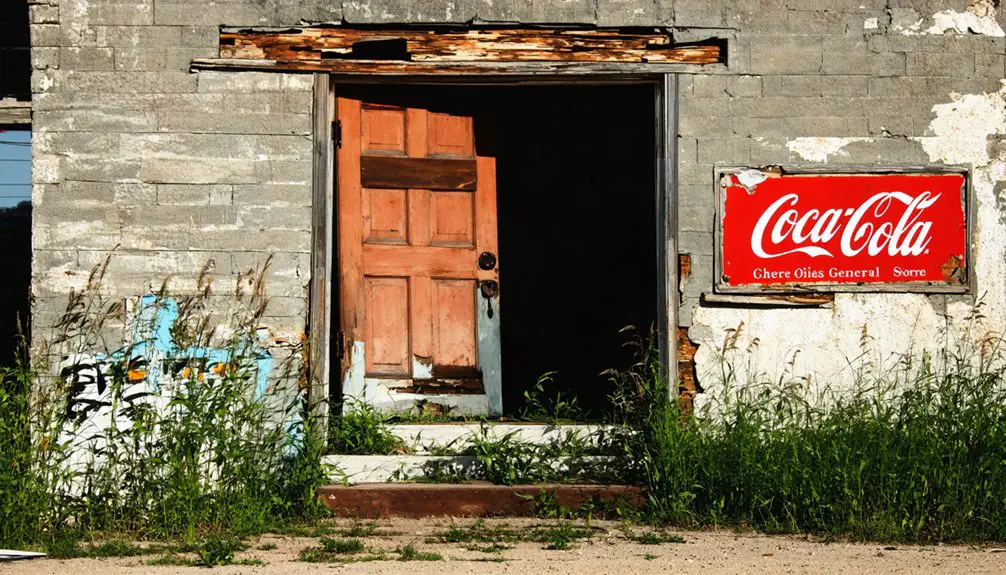You’ll find Cheek’s ghost town ruins in southern Carter County, Oklahoma, where rocky outcrops mark this former mining community‘s location at 814 feet elevation. Once a bustling company town during Oklahoma’s late 19th-century coal boom, Cheek thrived near major transportation routes, including the historic Osage Trace. Today, you can explore decaying wooden structures and industrial remnants via unpaved backroads, though the site’s toxic mining legacy tells a deeper story of boom-and-bust America.
Key Takeaways
- Cheek emerged as a company mining town in Oklahoma during the late 19th century before declining into a ghost town status.
- The town’s location in Carter County at 34°04′42″N 97°16′57″W features distinctive rocky outcrops that once aided navigation.
- Railroad expansion initially brought prosperity but later contributed to Cheek’s decline when automobiles and highways bypassed the town.
- Modern remnants include decaying wooden homes, a former motel, and service station buildings with rusty signage and broken windows.
- The site is now accessible via unpaved backroads but lacks tourism infrastructure and poses hazards from deteriorating structures.
The Rise and Fall of a Mining Community
While Oklahoma’s coal-mining industry boomed in the late 19th century, Cheek emerged as one of many company towns that dotted the state’s mineral-rich landscape.
You’d find miners and their families living under strict company control, where guards enforced rules and workers lacked political autonomy. The miners often found themselves in debt after being paid in company store scrip.
Despite harsh conditions and labor struggles, the community’s resilience showed as they adapted to dangerous work in room-and-pillar and slope mines. Similar to the tragic Monongah mine explosion, many mining disasters claimed the lives of young boys who worked alongside their fathers to support their families.
Geographic Location and Early Settlement
You’ll find Cheek situated in southern Carter County at coordinates 34°04′42″N 97°16′57″W, approximately 14 miles southwest of Ardmore, Oklahoma.
The area’s natural terrain included distinctive high cheekbones of rocky outcrops that helped early settlers identify and navigate the region.
Early transportation routes through this rolling plains region helped establish Cheek as a viable mining camp in the early 1900s.
The settlement’s position near rural roadways and its elevation of 814 feet made it an accessible location for the extraction activities that would define its brief existence. Like many settlements of that era, the area was valued for its ability to collect DNA samples for medical testing at the local doctor’s office.
Regional Transportation Routes
Located in Texas County within Oklahoma’s Panhandle region, Cheek’s development was heavily influenced by its strategic position near major transportation routes.
You’ll find that the area’s transportation evolution began with Native American trails, significantly the Osage Trace, which later developed into wagon roads like the Texas Road in the 1820s.
The rail significance became apparent in the 1930s when the Beaver, Meade and Englewood Railroad established service, followed by the Chicago Rock Island and Pacific Railway.
These competing lines created a crucial transport corridor that supported the region’s agricultural economy. The Rock Island Railroad influenced many local towns’ development, as seen in Hardesty’s relocation to align with the rail route.
While the railroads dominated freight movement through the 1960s, their decline in the 1970s shifted transportation primarily to trucks and highways, fundamentally changing the area’s economic dynamics.
The construction of new roads accelerated after the 1916 Federal Aid Highway Act provided matching grants for road improvements in the region.
Early Mining Camp Development
Despite its later significance as a mining town, Cheek initially emerged as a modest settlement in northeastern Oklahoma’s Ottawa County, near the Kansas state line.
The settlement was named after O.S. Picher, owner of the lead mining company that would transform the region. The social dynamics transformed rapidly after the 1913 discovery of lead and zinc ore during drilling on Harry Crawfish’s allotment. Mining technology quickly advanced as the Picher Lead Company established operations, attracting thousands of workers to the area. The area became so productive it supplied metal for ammunition during World War efforts.
- The settlement grew to cover 2.2 square miles, with over 14,000 miners working the mines at its peak.
- A sophisticated trolley system connected workers to nearby towns, including routes to Carthage, Missouri.
- Nearly 1,500 mining service businesses sprang up to support the booming extraction operations.
Economic Boom Years
During the mid-1920s, Picher experienced its most prosperous period as a bustling mining town, with approximately 14,000 residents drawn to the area’s abundant lead and zinc deposits.
Picher thrived in the roaring twenties, as thousands flocked to the Oklahoma boomtown’s rich mineral deposits.
Like many oil boom towns in Oklahoma during this era, the population surge brought rapid development and growth. This mining prosperity created a complex network of small mine owners, while railroads connected workers from distant towns like Carthage, Missouri. You’d have found the town bursting at the seams during this population explosion, with overcrowded streets and strained infrastructure.
The boom transformed Picher into a crucial hub within the Tri-State mining district, as trains hauled valuable ore across the region. The area reached peak production with 248 mining mills operating by 1927.
While nearby towns like Gua Miami and Peoria shared in the mining wealth, they didn’t face the same extreme overcrowding.
This golden age wouldn’t last, though, as the Great Depression soon triggered mine closures and mass exodus.
Environmental Impact and Mining Legacy
As mining operations intensified throughout Picher’s boom years, the town’s environmental legacy grew increasingly dire.
You’ll find a toxic legacy that’s left deep scars across the landscape, with massive chat piles containing dangerous levels of lead and zinc contaminating soil, air, and water. The environmental restoration efforts have already cost $600 million, yet full recovery could take another 50 years.
- Underground mine shafts created dangerous voids that left 86% of structures at risk of collapse
- Lead poisoning affected 34% of local children by 1994, causing severe health issues
- Tar Creek turned orange from mine drainage by 1979, destroying aquatic life
The devastating impact led to Picher’s designation as a Superfund site in 1983, forcing evacuation and leaving behind a ghost town that stands as a stark reminder of unchecked industrial practices.
Notable Buildings and Landmarks
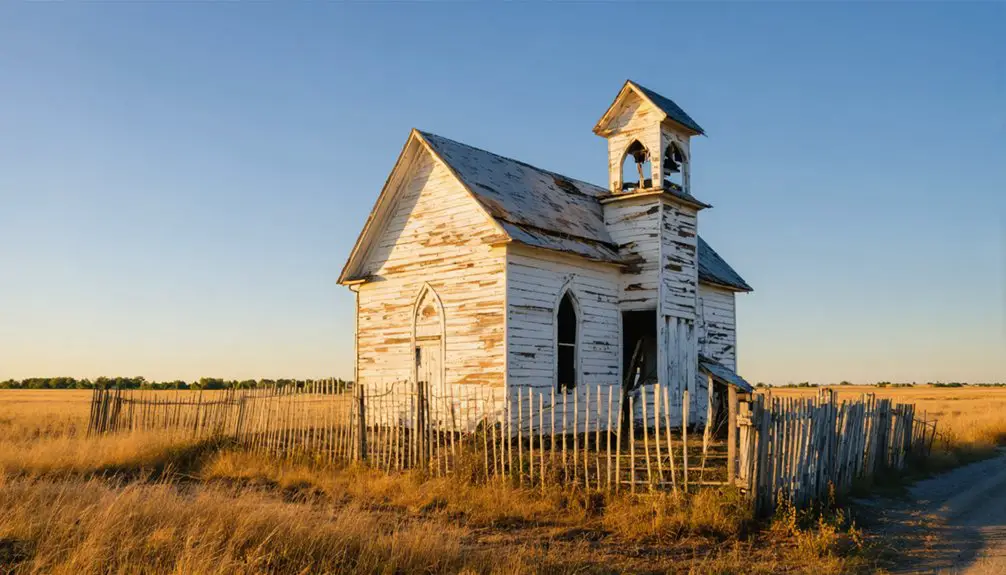
You’ll find several abandoned commercial buildings in Cheek, including small supply stores that once served local residents and travelers along the region’s main routes.
The town’s remaining churches stand as silent witnesses to the former community’s religious life, with adjacent cemeteries providing historical records of past inhabitants.
Abandoned worker housing units scattered throughout the area reflect Cheek’s past as a bustling mining community, complete with basic infrastructure that supported the local workforce.
Remaining Structures Today
The remaining structures in Cheek, Oklahoma paint a haunting portrait of this once-thriving community.
You’ll find several historic buildings still standing, though most are in various states of decay. The Magnolia Service Station, recognized for its architectural significance, stands as a symbol of 1930s roadside architecture and remains listed on the National Register of Historic Places.
- Old hotels and community buildings maintain their original facades, though many lack roofs and have broken windows.
- Historic preservation efforts focus on select notable structures, managed by local historical societies.
- You can still trace the original town layout through existing road beds and concrete foundations.
These deteriorating structures, while dangerous to explore, serve as silent witnesses to Cheek’s bygone era.
Historic Mining Infrastructure
Mining operations in Cheek relied heavily on slope mines carved into the region’s hilly terrain, featuring an intricate network of main entries and side tunnels supported by coal pillars.
You’d find miners working in tight spaces, often lying on their sides to undercut coal seams with picks before blasting. The mining techniques included vital safety measures like shale dust application to prevent explosions.
The infrastructure challenges were significant, requiring elevated planks throughout the mines to manage hazardous conditions.
Underground loading facilities connected to surface transport systems, while water management became essential to prevent flooding.
Railroad connections facilitated coal shipment to surrounding regions. The room-and-pillar system proved cost-effective compared to shaft mining, though it eventually led to structural instability and environmental concerns.
Transportation Routes and Their Effects
Through Oklahoma’s development, transportation routes played a crucial role in shaping Cheek’s rise and eventual decline.
You’ll find that the town’s transportation evolution followed a pattern common to many Oklahoma communities, from early American Indian trails like the Osage Trace to the influential Texas Road. The region’s economic changes were deeply tied to railroad expansion, which initially brought prosperity but later contributed to decline when service ended.
- The Texas Road, following today’s U.S. Highway 69, established essential north-south commerce routes.
- Railroad access through tribal lands after 1866 created boom conditions for connected towns.
- The shift to automobiles and highways bypassed Cheek, accelerating its path to ghost town status.
When rail service disappeared, Cheek lost its economic lifeline, and without major highway access, couldn’t adapt to changing transportation patterns.
Daily Life in Peak Years
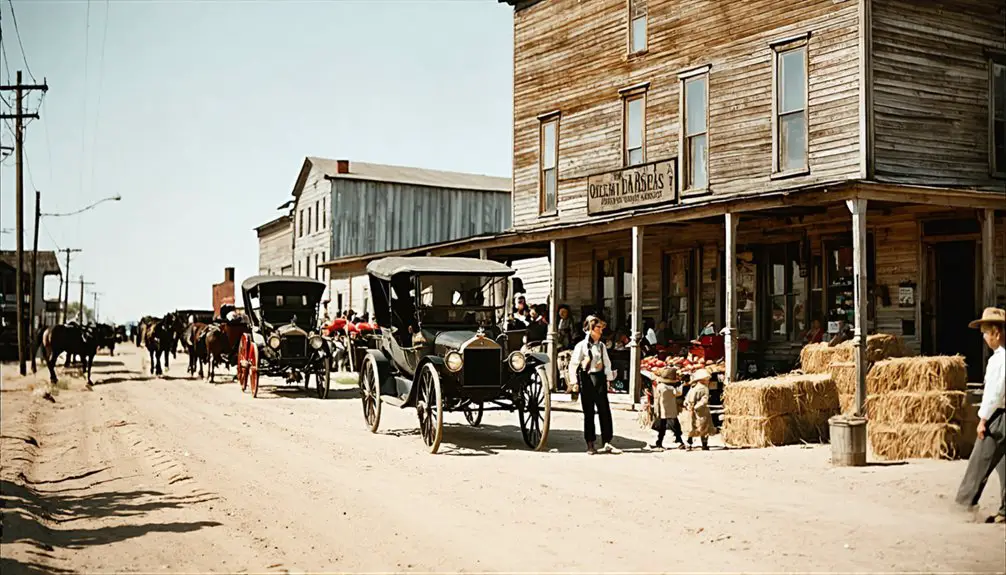
Daily life in peak-era Cheek centered around a bustling oil economy that shaped every aspect of the community’s existence.
You’d find yourself living in a hastily built wooden home or boarding house, sharing close quarters with other oil workers and their families. Your daily routines would revolve around the demanding schedule of the oil fields, while social gatherings at local saloons and dance halls offered much-needed relief from the grueling work.
You’d shop at stores stocked with basic supplies, and you might catch a show at the small theater in town.
Churches and schools struggled to maintain stability as people came and went, but you’d find strong camaraderie among fellow workers. The unreliable utilities and basic infrastructure meant you’d need to be resourceful to manage everyday challenges.
The Path to Abandonment
As natural resources dwindled and economic opportunities vanished, Cheek’s path to abandonment followed a familiar pattern seen across Oklahoma’s boom-and-bust towns.
Despite the community’s resilience, you’d have witnessed the town’s decline accelerate as transportation routes modernized and bypassed the settlement. The cultural heritage that once defined Cheek gradually eroded as families moved away, seeking better prospects in urban areas.
- When schools and businesses closed, the social fabric that held the community together began to unravel.
- Transportation shifts cut off essential commerce and tourism, leading to cascading business failures.
- Population numbers dropped dramatically, often leaving just single-digit residents before complete abandonment.
The town’s fate was sealed as remaining services shut down, and the post office’s closure marked Cheek’s official end as a viable community.
Modern Day Remnants
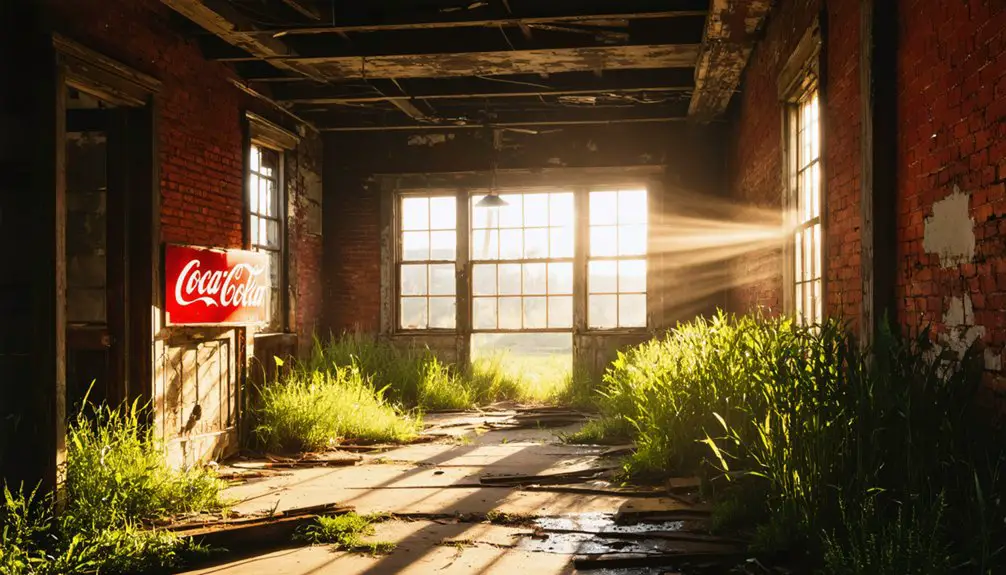
If you visit Cheek today, you’ll find decaying remnants of old homes, a former motel, and service station buildings that stand as silent witnesses to the town’s Route 66-era past.
The surviving structures, marked by rusty signage and broken windows, are surrounded by crumbling concrete foundations where other buildings once stood.
Due to structural hazards and deteriorating conditions, visitors should exercise caution when exploring the site, which remains accessible via unpaved backroads but lacks formal tourism infrastructure.
Ruins and Structural Remains
The decaying structures of Cheek, Oklahoma stand as silent witnesses to the town’s abandonment, with numerous buildings now reduced to advanced states of deterioration.
You’ll find structural decay throughout the former mining community, where nature steadily reclaims what humans left behind. The ghostly remnants include collapsed homes, rusted metal features, and crumbling foundations that tell the story of this once-thriving town.
- Foundation slabs and partial walls mark where schools and churches once served the community
- Former residential blocks feature gutted interiors, missing roofs, and warning signs about trespassing
- Industrial ruins and toxic chat piles remind visitors of the mining operations that once defined Cheek
The town’s layout remains visible through deteriorating roads and parking areas, though most structures are now unsafe to enter.
Safety and Access Issues
Modern visitors to Cheek face numerous safety risks and access restrictions that make exploring the ghost town a dangerous endeavor.
You’ll encounter gates, fences, and “No Trespassing” signs blocking unauthorized entry to many areas. The terrain poses serious safety concerns due to unstable ground from collapsed mine shafts, creating treacherous sinkholes that could give way without warning.
The EPA has declared the area uninhabitable due to toxic contamination from mining activities. You’ll find high levels of lead, zinc, and iron in the soil, while airborne dust from towering chat piles continues to spread contamination.
Though some roads remain accessible for limited driving tours, most are blocked off to protect you from environmental and structural hazards.
Historical Significance in Oklahoma
Oklahoma’s landscape bears the imprint of nearly 2,000 ghost towns, each telling a unique story of boom-and-bust cycles that shaped the state’s development.
You’ll find that ghost town origins in Oklahoma stem from diverse economic and social factors that led to their eventual economic decline.
- Mining boomtowns like Picher thrived until environmental hazards and resource depletion forced residents to abandon their homes.
- “Whiskey towns” such as Beer City and Keokuk Falls prospered from liquor trade until statewide prohibition in 1907 changed everything.
- Transportation shifts dramatically impacted town survival, as new interstate highways bypassed once-bustling communities like Texola.
These abandoned settlements stand as evidence to Oklahoma’s dynamic history, where changing economic conditions, environmental challenges, and shifting transportation routes transformed thriving communities into silent reminders of the past.
Frequently Asked Questions
Are There Any Documented Paranormal Activities or Ghost Sightings in Cheek?
Like a silent shadow, you won’t find documented ghost phenomena or haunting stories here. Research shows no credible paranormal activity reports, though Oklahoma’s ghost towns often harbor unexplored mysteries.
What Happened to the Cemetery and Burial Grounds After Abandonment?
You’ll find the cemetery largely abandoned, with minimal preservation efforts. Trees and undergrowth have overtaken most burial grounds, though sporadic maintenance occurs on select headstones, particularly one updated in the 1970s.
Did Any Famous People or Historical Figures Originate From Cheek?
You won’t find any famous residents or historical figures from this place – historical records and documentation show no notable personalities ever emerged from this tiny, forgotten Oklahoma settlement.
Were There Any Major Crimes or Notable Law Enforcement Events?
You won’t find any documented major crimes or notable law enforcement events in the historical record. The town’s crime history remained minimal, with no significant policing actions worth mentioning.
What Native American Tribes Originally Inhabited the Cheek Area?
You’ll find rich tribal history of Caddoan-speaking peoples, including Wichita, as early inhabitants, while Kiowa, Comanche, and Cherokee later influenced the area through their cultural influences and territorial presence.
References
- https://en.wikipedia.org/wiki/List_of_ghost_towns_in_Oklahoma
- https://www.youtube.com/watch?v=5d-wHDTIbb0
- https://www.okhistory.org/publications/enc/entry?entry=GH002
- https://www.youtube.com/watch?v=xg8SpCG-wDg
- https://www.youtube.com/watch?v=08y9RTS_nS4
- https://www.okhistory.org/publications/enc/entry?entry=MI042
- https://www.mininghistoryassociation.org/Journal/MHJ-v1-1994-Sewell.pdf
- https://www.youtube.com/watch?v=TadJRlcudTs
- https://dot.ca.gov/-/media/dot-media/programs/environmental-analysis/documents/ser/mining-study-a11y.pdf
- https://www.okhistory.org/publications/enc/entry?entry=MI041
